Duke has made great strides in expanding sustainability efforts across the operational and academic areas of campus and amplifying these efforts to the broader community. The work of the Campus Sustainability Committee (CSC) to expand the Climate Action Plan (CAP) into a broader Sustainability Strategic Plan (SSP) has guided much of this success. Since 2011, the CSC has assessed current efforts and developed goals around important topics such as water, waste, food, natural resources, sustainable investment, and procurement.
Since initiating the University's climate commitment in 2007, Duke has reduced the campus greenhouse gas footprint by 24%. Much of the reduction has come from investment in building energy efficiency, energy conservation projects, and discontinuing use of coal in campus steam plants.
The focus for the CSC this past year was updating the energy portion of the CAP, including reviewing progress to date, changes to assumptions that impact emissions, and consideration of new technologies, initiatives, and policies that could allow for even more aggressive on-campus reductions. This CAP update also allowed an opportunity to engage student interest and faculty stakeholders in a productive discussion of Duke's climate goals.
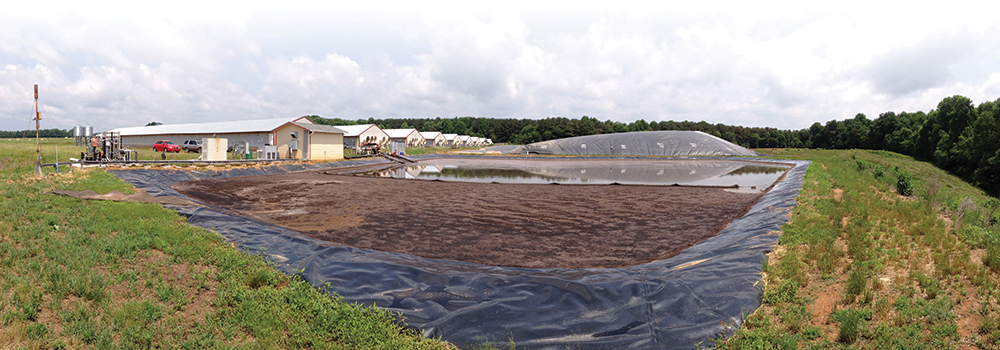
Duke's overall emissions are down 24% from a 2007 baseline. While energy emissions are down 36%, transportation emissions have only fallen 1% since the 2007 baseline. The University plans to focus on transportation this year to explore innovative ways to reduce these harder-to-impact emissions.
Duke Carbon Offsets Initiative (DCOI) has become the leader in higher education for carbon offset projects, advising other institutions on efforts to become climate neutral and sharing best practices through a new web resource Offsetnetwork.org.
In FY17, DCOI scaled the urban forestry offset tree planting program across North Carolina and in Arizona with a total of over 6,000 trees planted. DCOI also created an educational workshop on energy efficiency designed specifically for employees to implement energy reduction strategies at home.
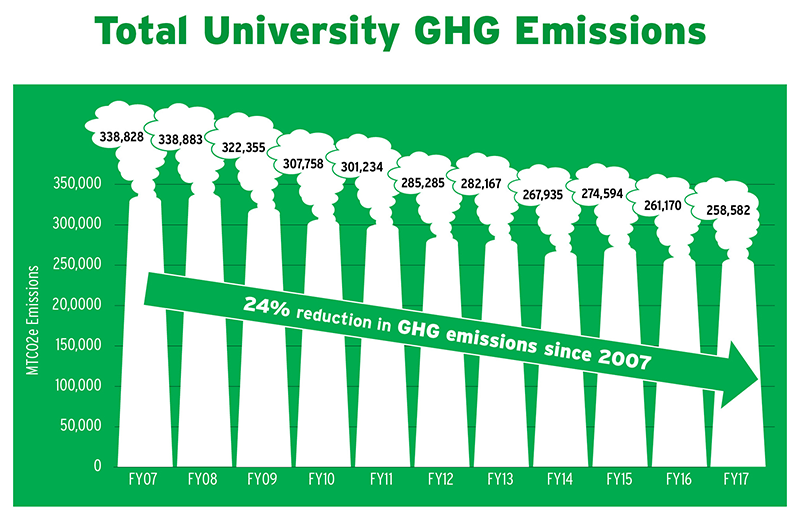
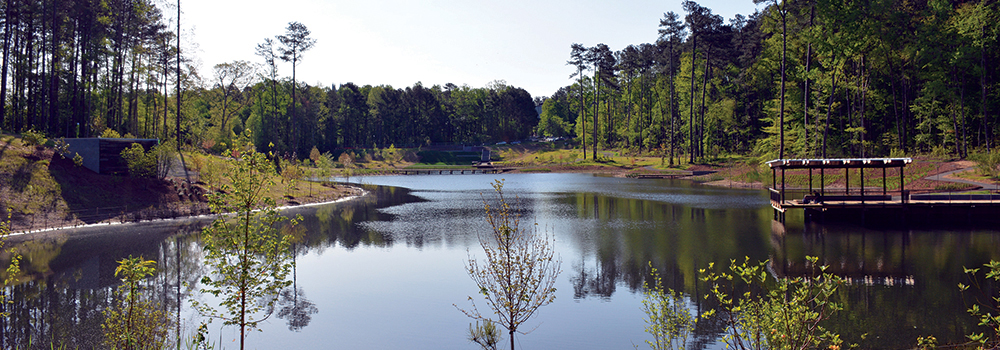
Existing building energy use is already down 12%, and Duke is currently considering an even more aggressive goal for reducing existing building energy consumption.
Since 2007, building-related energy emissions have decreased 36%. In FY17, Facilities Management continued this work through strategies such as lighting upgrades, district heating improvements, and laboratory ventilation system optimization. FMD is in the final planning stages for a large-scale LED lighting retrofit project that, when completed, will reduce the lighting energy used in 1.3 million GSF of campus buildings by 42%.
Duke has achieved a 40% reduction in potable water per gross square foot since 2006. This year, FMD utility systems reclaimed over 90 million gallons of alternative water for use in campus heating and cooling systems.
In FY17, Facilities Management completed a multi-year water audit and retrofit project resulting in the installation of low-flow plumbing hardware in the top 40 water-consuming University buildings. This 5 year project is already saving over 30 million gallons of water per year.
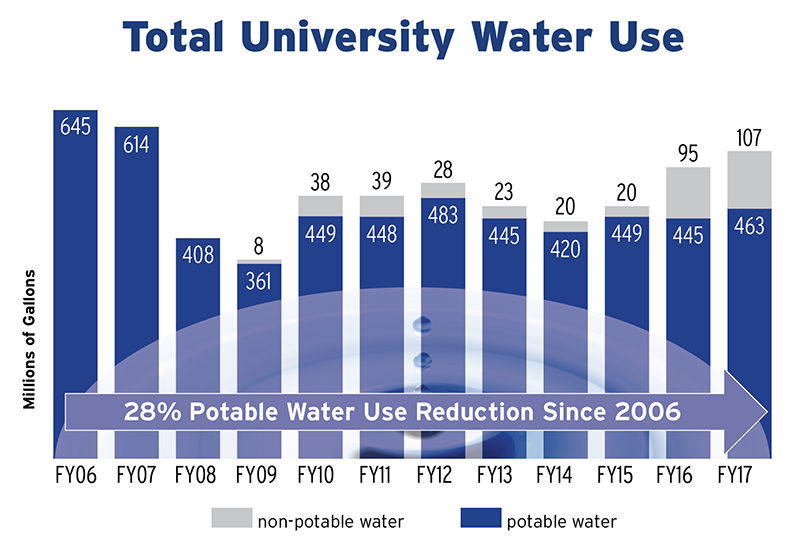
As of FY17, Duke has 41 LEED™ certified buildings and 7 buildings registered for certification. This represents 31% of the University's total square footage. Duke has also been implementing the Sustainable Building policy in new buildings such as the Wellness Center to operate 30% more efficiently than a standard building.
Duke continues to focus on maintaining the "campus in the forest" and educating the community on the importance of conservation through projects such as the Shepherd Nature Trail in Duke Forest, which educates visitors about ecology, history, and current research on site. On-campus efforts in FY17 included minimizing the impact of the Science Drive parking garage by building on an existing surface parking lot and reforestation of the site with a focus on native species.
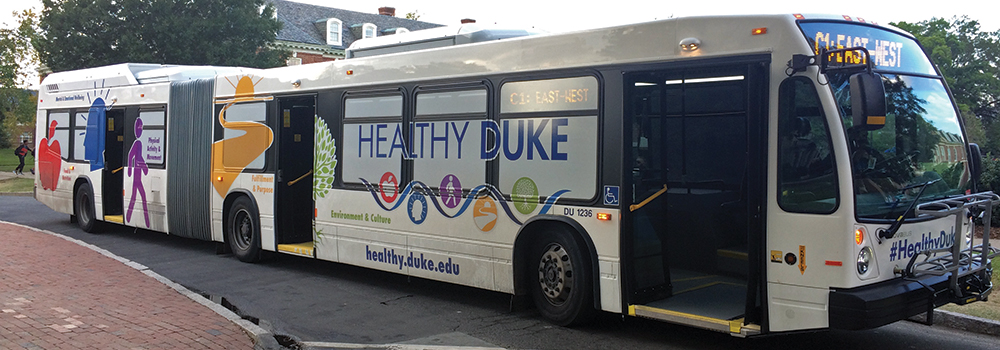
This past year, Duke Dining hired its first Sustainability & Quality Control Manager, updated its Sustainability Plan, and established a 2017 baseline for sustainable procurement efforts. This progress is included in the first Dining report on the ambitious sustainable procurement program. In recognition of these efforts, Duke Dining recently received the Gold Award in Sustainable Procurement from the National Association of College and University Dining Services, and the Marketplace received a 3-Star Green Restaurant Certification from the Green Restaurant Association.
In FY17, due to the addition of a full-time production manager, the Duke Campus Farm (DCF) grew more than 13,000 pounds and 40 varieties of produce for campus dining halls and Community Supported Agriculture (CSA) members. The 800+ volunteers and 12-member farm crew contributed indispensable thought and labor in the field.
In January 2017, DCF Program Director Dr. Saskia Cornes became an assistant professor of the practice at the John Hope Franklin Humanities Institute. She taught an introductory seminar on Sustainable Food Systems and co-taught The Environment in Literature, Law & Science with Profs. Dan Richter and Priscilla Wald.
Duke has worked diligently to influence employee decisions on how they commute to campus. However, drive-alone rates continue to fluctuate as external factors such as gas prices and regional transportation options influence these numbers. In FY17, drive-alone rates remained stable at 74%.
Parking and Transportation's efforts to provide robust alternative transportation options continued in FY17 with enhanced occasional parking options, development of a Bicycle and Pedestrian Plan for the University, as well as installations of new electric vehicle charging stations, bringing the total to 19 on campus.

As part of Duke's Supplier Diversity efforts, Procurement Services partnered with the Office of Institutional Equity to develop training and tools to better educate the Duke community to identify and utilize local woman-owned, minority-owned, and veteran-owned businesses. Procurement also worked with Housing and Residence Life on a comprehensive dorm room furniture RFP to identify a cost effective option for a small business with a local presence to supply sustainable, USA-made furniture for upcoming projects.
Since FY13, Duke Surplus has diverted over 60,000 items from the landfill and decreased institutional costs through a donation-only business model. In FY17, an education effort to increase departmental awareness about the program has resulted in a 46% increase in the internal utilization rate over the previous year.
Duke Sanitation and Recycling continued to partner with departments and students across campus to implement a successful zero-waste football season and decrease use of disposables on campus.
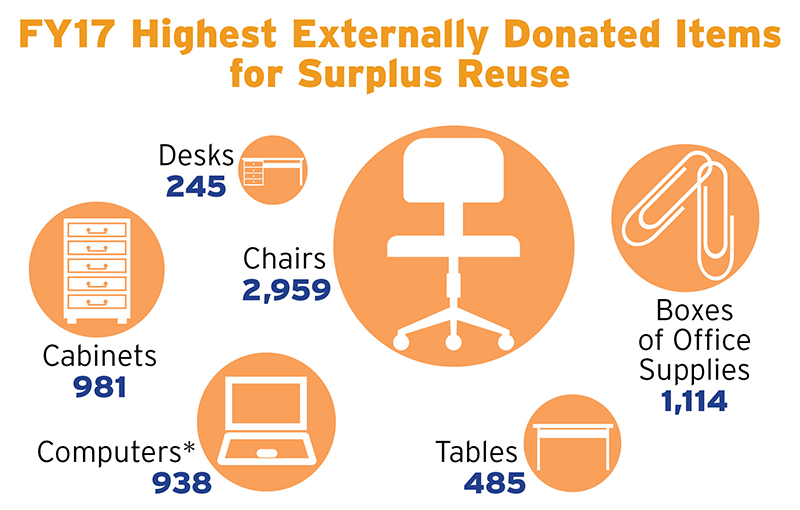

Duke continues to emphasize the importance of infusing sustainability into the student experience. The newly approved undergraduate experiential certificate in Sustainability Engagement now has six recently accepted students. Duke also has 141 participants from 12 different institutions as part of the Trillium faculty sustainability learning community, which began in 2010. In FY17, a new undergraduate initiative, the Curriculum for the Triangle Bioregion, has been taking shape to engage college students with concepts of environmental education and sustainability, especially in the context of their local communities.

Duke's sustainability community expanded to include a Green Dining Certification for vendors in the Brodhead Center, a Green Greek Certification, and the Duke University Hospital Green Team. Sustainability education reached new audiences at departmental staff meetings with abridged Green Workplace presentations. In FY17, over 100 staff members from five different Duke departments were in attendance.
Outreach on campus surged with the reinvigorated Green Devil internship and social media presence. In FY17, over 25 freshmen served as Green Devils on Duke's East campus. Fifteen Green Devils on West campus created new sustainability certifications, a spring environmental film-series, and completed a Zero Waste Pilot for Duke Basketball. Sustainable Duke on Instagram created a photo sharing community for sustainability at Duke with over 700 members in its first year.
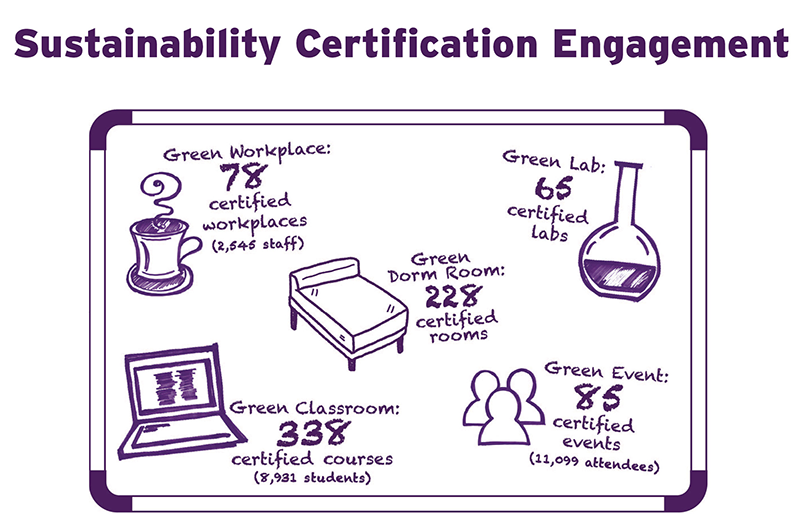

In the coming year, Duke will continue to update the 2017 Climate Action Plan (CAP) and begin implementation of updated energy emission reduction strategies, while the Campus Sustainability Committee (CSC) focuses on transportation-related emissions.
Duke will build upon the 36% reduction in energy emissions achieved since 2007 and aggressively pursue energy efficiency strategies in new and existing buildings, central utility improvements and renewable energy technologies where feasible. With or without the proposed CHP plant, Duke will continue to reduce energy-related emissions on campus with strategies such as expanding LED lighting upgrades, building HVAC optimization, chilled water system improvements, hot water conversion and renewables such as solar thermal.
The planning focus for the upcoming year will transition to transportation-related GHG emissions. The emissions from employee commuting and air travel have proven harder to impact due to their personal nature. This year the CSC, with the assistance of a Nicholas School of the Environment master's student, will take a hard look at opportunities to influence transportation-related behavior and new technology that might make choosing alternatives easier for the campus community.
With only seven years remaining until Duke's carbon neutrality target of 2024, Sustainable Duke looks forward to another year of collaboration with many partners to incorporate sustainability into infrastructure, operations and education at Duke.